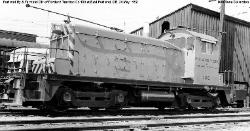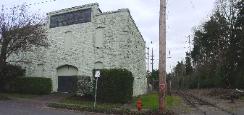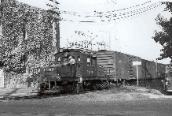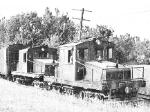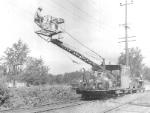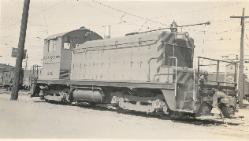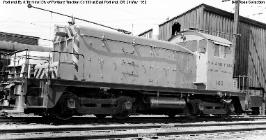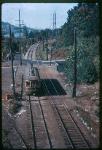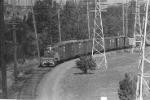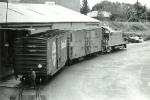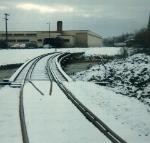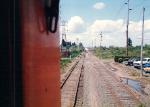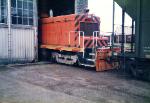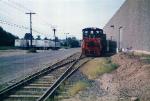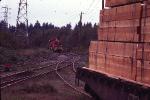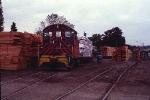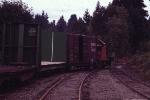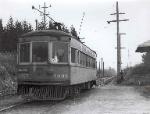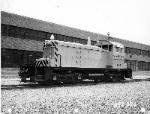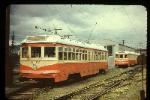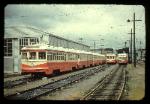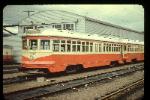| Last Update: November 4, 2013 |
| History of the OPR - East Portland Branch - Molalla Branch - Videos of the OPR in Action News & Upcoming Events - Photos of Past Events - Roster of the OPR Special Features |
| History of the OPR - East Portland Branch - Molalla Branch - Videos of the OPR in Action News & Upcoming Events - Photos of Past Events - Roster of the OPR Special Features |
| Copyright � 2004-2013 All Rights Reserved |

| HISTORY of the PORTLAND TRACTION CO. & PEPCO |


| THE BEGINNING The current Oregon Pacific Railroad East Portland Divsion is essentially the last 5 miles of what was once a vast network of electric railroads that extended all over Portland and into Oregon City, Gladstone, Boring and as far as Estacada and beyond, plus the East Portland Yard and Milwaukie Industrial Park. It all started in 1891, when the East Side Railway Co. was incorporated to build a line from the Columbia River to Eugene. Of course, it didn't exactly work out that way. But by July, 1891, part of the line we know today as the East Portland Branch of the Oregon Pacific, was constructed. This would not be the first trolley railroad to be built in Portland as over the prior 20 years, numerous horse car, cable car, steam car and electric car railroads had been built all over the city. But it would be the East Side Railroad Company that is the original predecessor to PEPCo and the Portland Traction Company as we would know it in the later years and it would be future assets of this company that would eventually take over almost all city and interurban and trolley line service in Portland. The East Side RY Company began by purchasing and consolidating several existing trolley and railroad companies in the area, such as the Mt. Tabor Street RY and the Mt. Hood RY company of East Portland. The first couple of years saw slower growth as the company built a few miles of track, including one of the original sections near 17th street in Milwaukie/Sellwood that is known today by OPR crews, as the "pass". A moderate, but long double track cut that spans the current 11th street to 17th street section of the OPR East Portland Division. By 1893, the line had reached south to Oregon City and Gladstone. Often described as an interurban trolley line, the railroad was designed to steam railroad specifications as it would eventually carry both freight and passengers. By 1895 the company had expanded to parts of inner Portland. But in 1900, the company went into receivership and assets were foreclosed on in 1901. The holder of those assets was a man named Fred Morris, who took over the remains of the East Side RY company and formed the new Portland City & Oregon RY Company. The line began to expand dramatically under the ownership of Fred Morris. He invested heavily in new cars and renewed plans to extend the line much further south into Eugene. The line was constructed as far as south as Gladstone with intentions to cross the Southern Pacific and run down to Salem. Intense opposition by the Southern Pacific Railroad trying to prevent competition in the Willamette Valley prevented the extension from going much further. However, the line through Lents and Gresham continued construction. By 1902, a dam site for a new power plant was surveyed and plans were layed out to run the line all the way out to Estacada and to what would later be known as Cazadaro where the new dam and power plant for the line would be located. As dramatic expansion was on the horizon exceeding the capabilities of the current corporation, the line would be reincorporated and renamed. The Oregon Water Power & Railway Company The name of the new corporation would be the Oregon Water Power & Railway Company. Although short lived as a corporate name, this would be the name of the company during one of it's busiest construction periods and as a consequence, the name has been immortalized on many a sign around the lines, some of which still exist today. The most notable being the still existing power sub station building located at Golf Junction. |
| INTRODUCTION This page is dedicated to the railroad that has gone by many names, but is best known as the Portland Railroad & Terminal Division of the Portland Traction Company. But most often simply called the Portland Traction Company. Also known from its earlier years through even today as the PEPCo. This is the predecessor company of the OPR's East Portland Division. What began as an electric railroad that ultimately spanned the entire city of Portland and beyond was paired down to it's last few miles by the time Richard Samuels and what would later become the OPR, would take over operations. But there is a vast history that dates back to 1891 and the remaining right of way still used by the OPR today dates to that era. The significance of the Portland Traction Company to the OPR goes well beyond just the fact that the OPR operates on the last few existing miles of PRTD right of way. The owner of the OPR, Richard Samuels, grew up near the PRTD and spent his entire childhood and many of his adult years admiring, studying, modeling and even helping and occasionally working for PRTD crews. The OPR website would not be complete without a section dedicated to the history of Portland Traction Company, its employees and everything that lead up to its creation and ultimate demise. While the Portland Traction Company may no longer exist as a railroad company, it's legacy lives on through the OPR East Portland Division and one of it's most famous locomotives, the PRTD No.100 continues to operate on the same PRTD line its been on since 1952. |
| Photo on the left is a photo of the PTC No. 100 shortly after it was purchased by the PTC in 1952. (Don Ross Collection). On the right taken less than a decade later is Richard Samuels next to his incredible Live Steam 1-1/2" scale replica of the No. 100. Little did he know at that time that 25 years later he would own the real thing and a few years after that he would even own and operate the railroad itself. |
| The Golf Junction Substation as it looks today. The substation was built as part of major expansions of the lines in 1905. Two photos on the left were taken in 2005. The OPR still runs right next to this substation today. Photo on the right is a picture of the substation half a century later during WW2, when PEPCo electric freight trains were using this same line. At that time, the electric sub station was covered in vines. Far right photo shows an old map of the lines under the OWP&Ry name. |
| By late 1902, the line had reached Gresham and the new dam site on the Clackamas River was purchased and secured. From 11th Street and Milwaukie, near the current Golf Junction, the route that is known today as the East Portland Divsion of the OPR, extending past Oaks Amusement Park and running along the Willamette River was beginning construction. A large car barn was constructed near Golf Junction during this period and the large brick building would survive all the way until 2003 when it was finally knocked down and replaced with condos. Photo links: The Sellwood Carbarn in the early years, photo date unknown. The line to Gresham was finished, but from Lents to Gresham, the line was not yet electrified as there was not enough power from the East Portland electric plant to supply the line. Steam power was used initially instead. A new electric plant in Boring was planned to be constructed once the lines reached that far. By 1903, the line had finally reached the new dam site and with the opening of the Boring electric plant, electrification was complete all the way to the dam site. 1904 would be the year that new line through Sellwood and along the Willamette River, that the OPR currently operates on, was completed. The main purpose of this line was to take interurban cars off of the city streets of East Portland and put them on a dedicated line. Work on the dam at Cazadaro was in full swing by then. Crews were now building numerous spurs and switches off of the line near East Portland and Water Street to serve future customers along the Willamette River. The building of this extension north along the waterfront cut off the east bank of the Willamette River in this area from any rail competitors who might otherwise have extended there. In 1905, the Troutdale Branch was built as part of a planned construction effort that was planned to eventually reach Camas, Washington via a ferry crossing on the Columbia River. However, the line ultimately would never extend across the Columbia River. Photo Links: Golf Junction during the OWP & Ry days. The substation in the background still exists. The line that the trolleys are sitting on is the OPR's East Portland Branch. And the line in the foreground is the Oregon City Branch, of which only this track shown, a couple of car lengths, still exists. A view of Golf Links station, later called Golf Junction, date unknown, but probably the early years. |
| Portland Railway Light & Power Company In 1906, the Oregon Water Power & Railway Company would be sold to several interested parties. Parts of the interests were the Milwaukie Road, who had planned to cross the Columbia and joint up with the Troutdale Branch and enter Portland via this route. The plan that never occurred. Also, the Oregon Electric Line was eyeing the Oregon City branch as a possible route for it to enter Portland. The Portland Railway Company wanted to purchase the inner city lines. And the Portland General Electric Company wanted to acquire the power plant on the Clackamas River at Cazadaro. By mid 1906, the company was turned over to joint ownership of the Portland General Electric Company and the Portland Railway Company. The Portland Railway Company was a conglomeration of remaining electric railroad companies within Portland that had merged over the previous few years. Assets of the company included a stock sale, which paid off stock holders of existing companies and helped the company to acquire more rail lines in the city. By 1906, they now owned over 100 miles of electric rail lines within the City and surrounding areas. In late 1906, the companies all merged to form the Portland Railway Light & Power Company. This company would control all city electric lines as well as the branch lines that ran to Oregon City, Troutdale, Gresham and to the dam past Estacada. In February 1907, the huge power plant at the Cazadaro dam was finally completed and would ultimately solve the power crisis that plagued the Portland electric lines for a period of time. Click here for old photo of the dam. For the first couple of years of the PRL&P Co, the former Oregon Water and Power Lines, such as the current East Portland Branch of the OPR was operated as a separate entity from the other city lines. This resulted in multiple problems and all lines were officially consolidated under one management in 1908. By 1911 the Mt. Hood Railway and Power Company Branch was built to accommodate construction of the Bull Run Power Plant on Sandy River, the intention was to extend the line as far east as Idaho. However, it ultimately proved to be a line to nowhere, when it only ended at the power plant near Bull Run, Oregon. It became part of the PRL&R Co. Railroad system in 1912 when the power plant and railroad were sold to PGE. Passenger service to Bull Run continued until 1930. Map of the Mt. Hood Division of the PRL&P. Photo Links: PRL&P Co. Trolley schedule for the Springwater Division (the same line that the OPR runs on today. Oregon City Cars 1093 and 1094 pictured in 1908. Golf Junction (still exists today, as the OPR East Portland Branch, although the station is long gone.) |
| The Portland Electric Power Company (PEPCo). By 1924 the PRL&R had financial problems and would ultimately need to be reorganized into a new company. This was the birth of Portland Electric Power Company. Otherwise known as PEPCo and sometimes shortened as simply the "PEP". The PEPCo era would extend well into the Portland Traction Company era and even through to today. The former Southern Pacific Interchange with the OPR at the former PEPCo East Portland Yards, is still officially referred to today on the Union Pacific Timetable and by Union Pacific crews as the PEPCo or PEP. This, decades after PEPCo ceased to exist. The new company began to rehabilitate the lines in the 1920s. The company would also branch out for the first time into passenger bus service. A brief financial turmoil period following the 1929 market crashed, caused the company to be temporarily reorganized under a different corporate name, the Pacific Northwest Public Service Company. The PEPCO name would remain as a subsidiary of the new parent company and PEPCO would operate the bus and rail lines of the new company. In a bit of a confusing period for corporate names and ownership, a new company called the Portland Traction Company was created and the interurban electric lines, which were no longer as profitable, were placed under its holdings in an effort to separate it from the city bus and rail lines. The short lived Pacific Northwest Public Service Company was ultimately dissolved in the mid 1930s and the corporate name officially changed back to PEPCO to placate the citizens who were becoming weary of outside "East Coast" investors taking over operations in Portland. It should be noted that from the PRL&R through the latest PEPCo, the owners and investors never really changed. Only the corporate name. Sometime in the early 1930s, the line to Estacada was severed when a major trestle near Boring burned down. By this time, there was no major business in Estacada and logging had largely ceased due to the Depression and there was little need to rebuild the line past Boring. By the late 1930s, the interurban service on the branch lines were becoming a major drain on the company. Riders simply didn't use the lines as roads and cars made travel much easier. PEPCo made an attempt to abandoned the interurban service in 1938 and 1939. PEPCo had hoped that the interurban lines could be sold off to a major freight railroad which would continue to operate them as a more profitable freight railroad. However, the major railroads were apprehensive if they had to take over the passenger service as well. 1940, yet another reorganization took place. PEPCO remained the main holding company, while the city lines were operated by a company called the Portland Traction Company, while Portland General Electric continued to operate the power and light side of the company. During World War Two, the fate of the line past Boring would be sealed forever, when the government was faced with the increased demand for war time logs and other products from the woods and mills near Estacada. They had a choice to either rebuild the trestles or widen the highway and ship by truck. They chose the latter and the highway to Estacada was widened and improved. A feature seen today by drivers who experience the abnormally wide highway that doesn't really go anywhere much beyond the small town of Estacada. After the war in 1946, PEPCo was again sold off to a California based company, called the Portland Transit Company. The city lines would remain under the control of the Portland Traction Company and a new company was formed called the Portland Railroad & Terminal Division in August, 1946. New reporting marks were PRTD. Portland General Electric was spun off as a separate company no longer related to the railroads. It seemed the new company and its investors were eager to sell off assets of the company for a profit. No efforts were made to extend the service of the interurbans and when the Hawthorne Bridge was rebuilt, the rails were removed, cutting off all electric car service on the west side. However, while electric rail service was ending, a new era was just beginning. The dieselization of the interurban lines and an expansion of freight traffic had begun. All likely an effort to increase the attractiveness of the lines to a freight railroad who might take over and purchase the operation. By 1958 it was all over for the trolley system and electric rail car service had ended. However the railroads that were built were not dead. Instead a new era would begin that would foreshadow today and the OPR operations on the East Portland Branch. Photo links: Sellwood Car Barn in 1930 (building in foreground still exists today. Line on right is currently the OPR East Portland Branch. Other Resources: For a listing and roster page, photos and info of the trolley cars used by the PRL&P, please visit this page. |
| The Modern Era of the Portland Traction Company Begins The name "Portland Traction Company" can be confusing and misleading, because over the course of the electric car era from the late 1800s through the late 1950s there were several different, but not related, companies that used this name. The last company to use this name and the one that continued into the 1980s was started as part of the Portland Transit Company purchase of the Portland Electric Power Company Lines in 1946. The operation were separated into several different companies. The Portland Traction Company would operate the city lines and the Portland Railroad & Terminal Division would operate the interurban lines. The Portland Traction Company would remain the official holding company for both operations. Thus, the freight operations that ran in the interurban lines were known officially as the Portland Railroad & Terminal Division of the Portland Traction Company. Electric Motor Locomotives which were formerly lettered PEPCo on the side of the frame, were relettered Portland Railroad & Terminal on the cab with the inititals P.T.Co on the frame. When new diesel locomotives were purchased in the early 1950s, they were lettered P. R. and T. Div. of the Portland Traction Co. on the side of the cab. Many people still referred to the line under its old PEPCo name for years, however, often just calling it the "PEP". In 1962, with the passenger service gone, the freight operations of the PR&T, Portland Traction Company were purchased jointly by the Southern Pacific and Union Pacific Railroads. This is the birth of the modern era Portland Traction Company. The two major railroads operated the Portland Traction Company as an independent subsidiary and shared control, not jointly, but alternatively. Which of the two railroads would oversee its operation would alternate every 2 years. The PRTD crews would often hide equipment and supplies in anticipation of the changeover every 2 years to keep the new company from either taking their supplies or refusing to replenish what they needed. |
| Electric to Diesel Locomotives, the Birth of Kellogg Industrial Park and the Death of Passenger Service Despite the new owners seemingly motivations to turn a quick profit on the sale of assets, some major improvements and construction projects were begun on the lines, mainly to help make them more attractive to potential railroad buyers. The Kellogg Industrial Park, also known as the Milwaukie Industrial Park and the location of the last remaining customers on the OPR's East Portland Branch, was born. The company purchased the old war housing property in Milwaukie and built spurs into the new property with plans to separate and sell off lots to new businesses that would need rail service. Lots were sold with the stipulation that the owners would use rail service. The new property had to be accessed off of the PRTD mainline east of 17th street via a very steep 6% grade that is still in use today. The area was not electrified so this would require the purchase of new diesel locomotives and beginning of the end of electrification and passenger service on the lines was at hand. The options for the PRTD at that time were GE 70 tonners or EMD SW1s. The PRTD chose the EMD SW1 because it was less expensive. PRTD No. 100 was purchased in 1952. A second SW1, numbered 200 was purchased in 1953. From 1953 through 1958, the new diesel switchers operated in conjunction with the remaining electric rail cars. Because the crossings warning systems were all activated by electric switches on the overhead wires, the diesels had to be equipped with trolley poles to operate on the entire system. These trolley poles gave the diesels a unique and interesting look. The Portland Traction Company had wanted to end interurban trolley service for years, as it slowly cut back the city lines down to only the remaining interurban trollies. Busses, trolley busses and cars reduced passengers to unstustainable levels and the company was losing money. By the early 1950s, the company was attempting to abandon trolley service. But an organized community campaign saved the line for several more years. The company has already replaced the few remaining city trolley lines with gasoline or diesel busses by the early 1950s. All that remained by the early 1950s was a connection to SW 1st and Washington (downtown Portland) south over the Hawthorne Bridge to Oregon City, Bellrose and Gresham. Now they focussed on shutting down the interurban lines. Their application to abandon the lines was refused in April, 1955 by the Oregon Public Utilities Commission. But in 1956, construction projects on the Hawthorne bridge caused the removal of the trolley tracks and severed the line from downtown. The new beginning of the line was now on the east side, at SE 1st and Hawthorne. Ridership dropped even further. Portland Traction Company illegally and unexpectedly stopped all service on January 25, 1958 in defiance of the Oregon PUC's orders. The issue was not resolved until 1962 when the Oregon Supreme Court ruled that the Oregon PUC infringed on the Portland Traction Company's property rights when it ordered them to continue service. That same year, the Portland Traction Company would be purchased jointly by the Southern Pacific and Union Pacific Railroads. |
| The Abandonment of the Oregon City Branch The branch line to Oregon City was the first major branch line of the PRTD to be abandoned. By the early 1960s, most businesses along the branch were gone and the line only served a paper mill at the end of the 8 mile long branch. However, the paper mill could be served by the SP from it's mainline instead. The line was closed by 1968. Reasons for closure were few customers on the line a bridge that needed replacement, but was not cost effective. With the parent company of the PRTD already having an alternate route to reach the major customers on the line and with the cities interested in removing the in street trackage, there was little to no reason to continue service. Today the original switch to the Oregon City line remains in place at Golf Junction and a short section of track takes off of the former Portland Traction Company mainline and disappears into the brush after several car lengths. The PRTD and later the OPR used this short remaining section of track for car storage. The in street track that existed in Oregon City was paved over. The bridge over the Clackamas River kept its decking for a few decades later, but today has no decking and is blocked off to access, although the bridge itself remains in place, as a conduit for power and water lines across the Clackamas. The old railroad spur is currently being converted into a public trail. Ironicly, while this was the first branch line to be closed by the new Portland Traction Company, it would be this line that caused the PRTD to remain in existence as a paper corporation, long after the Samuels family purchased the remains of the PRTD railroad operations. The Portland Traction Company retained ownership of the right of way and property of the Oregon City branch line although the rails were removed. When the PRTD sold its operations and remaining Boring Branch to Metro to be converted into a trail and the East Portland line to Richard Samuels, it retained control over the Oregon City line property and remained in existence as a paper corporation, owning that property until just recently when it was sold to create a new trail system and the company finally dissolved. |
| Map of the system under the PRL&P company name. This is probably around the peak of the system in terms of the trolley lines. Map created in 1918 and last updated in 1922. This would be just prior to the reorganization into PEPCo that would follow a few years later. These are what was known as the city lines. The interurban lines would branch out outside the city. See below for an interurban line map. |
| Oaks Amusement Park In 1904, plans were underway to build a new amusement park along the Willamette River that could spur trolley business for the lines, by using the new trolley system to bring customers directly to the park. The park was built by the Oregon Water Power and Railroad Company to increase business on the lines, especially on the otherwise slower weekends. The amusement park featured one of the largest roller rinks in the northwest and numerous other attractions. It would not be the only amusement park in the Portland Area, but it would ultimately be the last and it continues to survive AND thrive even today. The OWP&Ry built a spur off of it's line that ran down towards the park and then turned into a balloon track that looped back around, allowing trolleys to make one continuous loop to and from Oaks Park. To view historical photos of the Oaks Park, including the related trolleys, check out this site. To visit Oaks Park Current Website and Operations, click here. |
| From left to right: (1) Electric freight motors operating near Golf Junction in 1948. (2) Electric freight motors at Golf Junction in 1942. (3) Sweeper car in storage at the East Portland Yards in the later years. (4) Trolley cars meet as viewed from inside the Trolley car, somewhere near Oaks Park. (5) Trollys and a caboose at the far eastern end of the line in Cazadaro, east of Estacada, Oregon. |
| From left to right: (1) PTC No. 100 photographed at East Portland only a few months after it was purchased in 1952. Don Ross Collection. (2) No. 200 photographed at East Portland Yards in 1956. (3) EMD builder's photo of the No. 200 prior to delivery to the PTC. |
| From left to right: (1) After the trolley system was shut down in 1958, most of the trolleys were burned and scrapped out. (2) Scrapping the interior of a trolley. (3) No. 200 still with its trolley poles likely taken sometime prior to 1958. (4) Scrapping of the overhead wires occurred around 1960, shown here a contractor used a custom built machine to lower the wires and then cut them in approximate 1 foot long sections for easy scrapping. Sameuls Family Collection |
| All photos are from the Samuels Family Collection, taken by Richard Samuels. Most photos appear to date from the early 1960s to approximately the late 1960s. |
| From left to right: (1) Photo looking north from the Sellwood bridge as a southbound trolley heads towards Golf Junction. (2) Photo looking south from the Ross Island Bridge as a northbound trolley heads to East Portland. Both taken by Robert T McVay most likely sometime in the 1950s during the final years of trolley operations. The OPR currently operates over the track seen here in these photos. |
| All photos are from the Samuels Family Collection, taken by Richard Samuels. Most photos appear to date from the 1960s to the 1970s |
| The Portland Traction Company, the Later Years and Decline In the 1970s and 80s, the PRTD began to languish as rail traffic declined. By the 1980s, the last remaining trackage was the line between the East Portland Yard, interconnecting with the Southern Pacific to north, that extended south to Milwaukie and then east to Boring. Approximately 22 miles of track. However, the majority of traffic came from the Milwaukie industrial park. The owners of the company, the Southern Pacific and Union Pacific were facing financial issues and had been deferring maintenance on lesser used branch lines for years. They were even less inclined to invest back into a subsidiary company that neither railroad fully owned or controlled. The PRTD lines were rarely upgraded and maintenance was kept to the minimum. The same diesel engines that had faithfully served since the early 1950s continued to be used. With little prospect of increased business it was becoming clear that the future would be bleak. The only question was when. Federal laws made it difficult to just abandon a line and the parent companies kept the operation going, even to the point that trains were only running one day per week. By the 1980s, the Portland Traction Company was only shipping about 127 carloads a year and was losing around $400,000 per year for the big railroads. Craig Bass's PRTD article and photos about the operation in 1981. |
| An Idea is Born - One Man to Buy and Operate a Railroad In 1986, the PRTD sent notices to its shippers that it intended to abandoned its Boring branch and were looking at options to continue service to the remaining customers at the Milwaukie Industrial Park. Knowing that the end was near for the PRTD would become the birth of the idea of Richard Samuels owning and operating a railroad. In 1986 he wrote the parent companies of the PRTD that he was interested in taking over the operations of the PRTD. At first the parent railroads did not take him very seriously, but he persisted. The PRTD had received permission to abandon the Boring line and was interested in selling the remaining trackage to Mr. Samuels to avoid abandonment proceedings. Mr. Samuels stipulated that he wanted the salvage rights to the Boring line in exchange for taking over the PRTD, so that he could use the good track on the Boring branch in the future refurbishing of the line between Milwaukie and East Portland. By the late 1980s, the track was abandoned east of Milwualkie and sold to the local governments who turned it into the Springwater bike trail. During this same period, Mr. Samuels, who owned a steel company in Milwaukie that was a customer of the PRTD, saw an opportunity to save the fledgling railroad. With the UP and SP wanting to abandoned or sell the line, Mr. Samuels stepped up and formed the East Portland Traction Company, to distinguish himself from the Portland Traction Company in 1987. One of his first aquisitions would be purchasing the No. 100. But not from the PRTD. The No. 100 had been sold off in the mid 1980s to a paper mill in Wallua, Washington. The mill had mistakenly replaced a SW1200 with a locomotive of half the power and was regretting the purchase and looking to sell it quickly. Mr. Samuels was able to purchase it and bring it back to his steel fabrication shop and storage property with the intention restoring it and eventually using it to salvage the Boring branch and ultimately to operate over the PRTD when he took over the railroad. |
| All photos are from the Samuels Family Collection from approximately the 1970s. No. 200 in front of the shop probably early 1970s. Photos of the East Portland Yards and the last photo on the right is looking south along the line between Oaks Park and Spokane Street. |
| Views around the line in the late 1970s and mid 1980s. From left to right: (1) Showing the Johnson Creek bridge on the current AmeriCold spur with the Boring Branch bridge in the background (2) Looking south at the Johnson Creek bridge, showing the former spur going into the OLCC building. This spur has since been removed. (3) East Portland yards taken sometime in the mid 1980s. |
| The Final Years of the Portland Traction Company By the late 1980s, there was little doubt that the days of the Portland Traction Company were numbered. The Boring branch was about to be abandoned. Trains were running maybe once per week. The PRTD was preparing to sell off both SW1s, the No. 100 and 200 to Fantasia Trains, who in turn broker them them off to new owners. Around 1986, the 100 would leave property first, followed by the 200 later. They were going to utilize local switcher engines from the parent companies instead. The engines could be maintained by parent company fleet and this would save on costs. SW1500s from the Southern Pacific were utilized in the final years. |
| Views around the line in the late 1970s through the 1980s. Samuels Family Collection. |
| Two photos on the left show the No. 100 after it arrives back on the PRTD after Mr. Samuels purchased it in 1987. Shown here in storage on Samuels Steel property that would later become the OPR shops. Middle photo shows the freshly painted No. 100 not long after being brought back to the PRTD lines, pulling the SP&S 700 out of Oaks Park where it was to be taken to the Brooklyn Roundhouse and restored. Last photo shows the No. 100 switching out Mr. Samuels Steel Fabrication Shop. Samuels Family Collection. |
| Richard Samuels documented the last run of the No. 200. Not long after this, it was sold to it's new owners, the CHSX, known today as the Cenex Harvest States Cooperative. The exact date of these photos is not know, but believed to be around the mid to late 1980s. Samuels Family Collection. |
| Photos of the No. 200 being pulled out of the PTC shops and shipped off the PTC to its new owners. Exact date unknown, but appears to be around the mid to late 1980s. Samuels Family Collection. Photos of the No. 200 from 1999 working for the CHSX, Cenex Harvest States Cooperative. |
| Southern Pacific SW1500s being used by the PTC crews in the final years of operation. Samuels Family Collection. |
| All Done - A New Era Begins 1991 would be the final year of operations for the PRTD. By April 1, 1991, the PRTD ceased to exist as an operating railroad and Richard Samuel's new East Portland Traction Company officially went into operation and took over the remaining track and shipping. For several years prior, Mr. Samuels and his crew had been scrapping the Boring Branch line and had plenty of experience operating and repairing railroad equipment and doing track work, so the switch over was any easy one. Mr. Samuels made contact with each shipper and offered his phone number telling them that he would be willing switch them and provide service any day or time. It would be the beginning of a new era. As expected and envisioned by Mr. Samuels, business picked up and line once again became profitable. |
| EPTC No. 100 at East Portland in the very early years of operations. Samuels Family Collection. |
| Additional Resources and Reading. An article about the PEPCo and Portland Traction Company in Traction Models Magazine from November 1968 |
| Richard Samuels photographed the last run on the Oregon City Branch by the PRTD in 1968. He had tried to convinced the PRTD crew to use the historic No. 100 in the final move, but they already had the No. 200 out and would be using it instead. |
| Milwaukie and beyond. These maps show the old Portland Traction railroad that used to run beyond Milwaukie to Boring but was abandoned and scrapped just prior to Mr. Samuels taking over the operation. |
| These photos were taken by and are courtesy of Louis Thelen and were taken while chasing the Portland Traction Company in 1977. Included are shots of both the 100 and 200 in Milwaulkie, Portland and on the Boring Branch. |
| Oregon City Division, PRTD 1951 time table |
| Bellrose Division, PRTD 1951 time table |
| Oregon City Division, PRTD 1948 time table |
| Oregon City Division, PRTD 1949 time table |
| Oregon City Division, PRTD 1956, 1957 time table |
| Oregon City Division, PRTD 1955 time table |
| These timetables represent the last divisions of the Portland Traction Company Trolley System from the late 1940s through the late 1950s. The Oregon City Division, Gresham Division and Bellrose Division. These Divisions originated in Portland, north of the East Portland Yards and operated on the same track south through Golf Junction. At Golf Junction, the Oregon City Division split off on the Oregon City Branch, while the Bellrose Division continued east towards Lents, terminating at Bellrose. The Gresham Division continued from Lents to Gresham. |
| These photos are part of the Ken Shattock collection and appear to date from around the early 1940s through the early 1950s. All locations are not known just yet. |
| Track diagram sketches drawn in 1981 by Craig Bass of the, East Portland Yards, Golf Junction, Milwaukie Industrial Park, Gresham and Boring at that time. A lot of changes have taken place since then. http://craigsrailroadpages.com |
| No. 200 in 1972 right after it was repainted, including new yellow safety colors, probably from Union Pacific influence. Brian McCamish Collection. |
| Bellrose Division, PRTD 1956 time table |
| Gresham Division, PRTD 1948 time table |
| PTC crews work on a wreck, possibly west of 82nd street in Portland. Likely taken in the 1940s. |
| Basic map showing the major interurban lines of PEPCo and the different interurban divisions. |
| Oregon City Division, PEPCo 1942 time table |
| Additional Resources and Reading. An article about the Portland Traction Company in the Western Railroader magazine August 1958 |
| PTC "Hollywood" cars tied up at the East Portland Yards, probably in the final years of trolley service. |
| PTC Trolley at Oaks Station in the summer of 1957. |
| Oregon City Division |
| Bellrose Division |
| Gresham Division |
| PRL&P Passenger Timetable from 1914 (photo copy) |
| Bellrose Division, PRTD 1957 time table |
| Employee timetable for the Portland Traction Co. 1974 |

